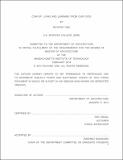| dc.contributor.advisor | Rafi Segal. | en_US |
| dc.contributor.author | Ong, Richard (Richard Liou-Yuan) | en_US |
| dc.contributor.other | Massachusetts Institute of Technology. Department of Architecture. | en_US |
| dc.date.accessioned | 2014-05-23T17:16:06Z | |
| dc.date.available | 2014-05-23T17:16:06Z | |
| dc.date.copyright | 2014 | en_US |
| dc.date.issued | 2014 | en_US |
| dc.identifier.uri | http://hdl.handle.net/1721.1/87147 | |
| dc.description | Thesis: M. Arch., Massachusetts Institute of Technology, Department of Architecture, 2014. | en_US |
| dc.description | This electronic version was submitted by the student author. The certified thesis is available in the Institute Archives and Special Collections. | en_US |
| dc.description | Cataloged from student-submitted PDF version of thesis. | en_US |
| dc.description | Includes bibliographical references (pages 104-105). | en_US |
| dc.description.abstract | How many of us actually know what we are eating? Our relationship with food is one of consumption. We see food, we eat food. Our current food life cycle model delivers meals directly to our plates with little or no oversight. Food has become an autonomous product; its connections and relationship to the land and people are hidden, many times intentionally. Education is key to successfully addressing all the problems that our current food / farm model is producing. While much can be learned from textbooks. A physical connection to the land, people and animals that provide our meals is more mutually beneficial. There is reciprocity between one's actions and their effects that simply cannot be achieved by only reading or watching. Complete immersion makes connections more immediate and relatable at a human scale. The design strategy focuses on animal behavior and needs. The land is manipulated to the benefit of the animals with the intention of developing a system that allows for appropriate and sustainable use of the land while providing adequate control by animal handlers. Cow-Op is a school where students come to learn and build physical bonds with the land and animals that feed them. The school will be designed as a dormitory cooperative where student live and share the responsibilities of caring for themselves and those they live with, including the animals that live alongside. Programs will focus around the full life cycle of livestock and how they contribute to our various needs. From basic living and feeding needs to producing and harvesting. The school will also take the food stuffs and bring them to market to understand how the global economy functions and its relations. There will also be culinary and manufacturing facilities to bridge the role of raw goods with their final consumables. | en_US |
| dc.description.statementofresponsibility | Richard Ong. | en_US |
| dc.format.extent | 105 pages | en_US |
| dc.language.iso | eng | en_US |
| dc.publisher | Massachusetts Institute of Technology | en_US |
| dc.rights | M.I.T. theses are protected by copyright. They may be viewed from this source for any purpose, but reproduction or distribution in any format is prohibited without written permission. See provided URL for inquiries about permission. | en_US |
| dc.rights.uri | http://dspace.mit.edu/handle/1721.1/7582 | en_US |
| dc.subject | Architecture. | en_US |
| dc.title | Cow-op : living and learning from our food | en_US |
| dc.title.alternative | Living and learning from our food | en_US |
| dc.type | Thesis | en_US |
| dc.description.degree | M. Arch. | en_US |
| dc.contributor.department | Massachusetts Institute of Technology. Department of Architecture | |
| dc.identifier.oclc | 880137833 | en_US |
